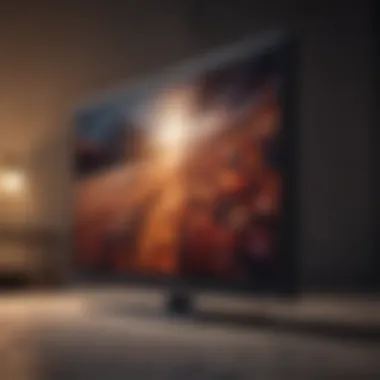Effective Methods to Clean Your LED TV Screen


Intro
Cleaning an LED TV screen is not merely a chore—it is a necessity for maintaining the quality of your viewing experience. Many individuals underestimate the importance of proper cleaning techniques and tools when it comes to their expensive televisions. Using inappropriate methods can lead to unsightly marks, scratches, or even permanent damage. This initiative is aimed at dissecting effective methods tailored specifically for LED screens, ensuring that readers are well-informed about the nuances involved.
Understanding the unique properties of LED displays is crucial. Unlike traditional screen types, LED screens are sensitive to harsh chemicals and abrasive materials that can mar their surface. Effective cleaning methods not only restore your screen’s clarity but also extend its lifespan. In the following sections, we will delve into the recommended cleaning agents, tools, best practices, as well as safety precautions to consider while you attend to your device.
Before proceeding, we need to highlight some essential tools and materials that will aid you in cleaning your LED screen effectively. Familiarity with these items will empower you to maintain your screen effortlessly.
Essential Tools for Cleaning Your LED TV Screen
- Microfiber Cloth: This is the most suitable fabric for cleaning purposes. Its fine texture is gentle on screens, minimizing the risk of scratches.
- Cleaning Solution: A specially formulated screen cleaner or a mixture of distilled water and white vinegar is recommended. Avoid general-purpose cleaners, as they can contain harmful components.
- Spray Bottle: For applying your cleaning solution evenly without oversaturation.
Key Considerations Before Cleaning
- Power Off Your TV: Always turn off your LED TV and unplug it before cleaning. This is a safety measure and it allows you to see dust and smudges more clearly on a dark screen.
- Check for Warranty: Sometimes, manufacturers provide guidelines or recommended products for cleaning that must be adhered to in order to maintain your warranty.
Understanding these basics sets the stage for effective cleaning techniques. Let's navigate through the proper procedures in the next section, which will ensure a thorough yet safe cleaning experience.
Understanding Your LED TV Screen
Understanding the structure and functionality of your LED TV screen is crucial for effective maintenance. Knowledge about this technology allows users to select the proper cleaning methods and materials. This section delves into the basic components and common issues associated with LED screens, setting a foundation to support effective cleaning practices.
Structure and Components
An LED TV screen consists of several important parts that work together to create the vibrant images we see. The primary elements include:
- LED Backlight: This consists of many tiny bulbs that provide the necessary light for the screen.
- Liquid Crystal Display (LCD): In most LED TVs, an LCD is overlaid on the backlight to modulate the light and produce colors.
- Polarizer Films: These films help manage the light's polarization and enable the display to present clear images.
- Glass or Plastic Layer: This protects the internal components and can impact the overall quality of the picture.
Understanding these components assists in recognizing why delicate cleaning is pivotal. Certain cleaners can damage the polarizer or scratch the glass, leading to serious display issues.
Common Screen Issues
Various problems can occur with LED screens, often exacerbated by poor cleaning habits. Common issues include:
- Dust Accumulation: Dust can easily settle on the screen, making it necessary to clean regularly to maintain clarity.
- Fingerprints and Smudges: Direct contact often leads to unsightly marks, which require gentle cleaning methods.
- Screen Burn-In: Prolonged static images may lead to burn-in, although it's more common with older technologies than modern LEDs.
- Clouding: This can happen when moisture or dirt gets trapped within the layers of the screen, obstructing image quality.
Awareness of these challenges highlights why careful cleaning is essential, not just for aesthetics but for the longevity of the device.
Why Cleaning is Important
Cleaning an LED TV screen is a task that should not be overlooked. Many people often underestimate the significance of this process, assuming that occasional dusting is sufficient. However, maintaining a clean screen goes beyond aesthetics; it ensures optimal performance and extends the life of the device.
Effects of Dust and Dirt
Over time, dust and dirt accumulate on the screen. This debris can create a hazy appearance, dulling the vivid colors and contrasting visuals that LED displays are known for. Moreover, not just the surface is affected. If dirt particles infiltrate the internal components, they can lead to overheating or even malfunctioning of the device. Regular cleaning prevents the buildup of these particles, preserving the clarity and vibrancy of the display.
Impact on Picture Quality
The quality of the viewing experience directly correlates with how clean the screen is. A screen laden with fingerprints, smudges, and other residues can severely detract from picture quality. Colors may appear washed out, and details are less distinguishable. For those who appreciate quality visuals—be it for gaming, watching movies, or viewing presentations—a clean screen is essential. Keeping it clean ensures that every pixel is displayed as intended, which enhances immersion and overall satisfaction.
Longevity of the Screen
An often-neglected benefit of regular cleaning is its contribution to the longevity of the screen. Dust and dirt often contain abrasive particles that can scratch the screen. Over time, these scratches accumulate and degrade the panel's integrity, leading to permanent damage. By implementing a routine cleaning schedule, users can significantly reduce the risk of such damage. This proactive approach not only maintains the appearance of the screen but also prolongs its functional life, ultimately saving on costly repairs or replacements in the future.


Materials for Cleaning LED Screens
Cleaning an LED TV screen involves more than just wiping it down with any cloth or liquid. The choice of materials plays a crucial role in maintaining the screen's quality and performance. Using appropriate cleaning tools and solutions ensures that the display remains free from scratches, streaks, and other potential damage. Each material used should be gentle yet effective, providing a balance between cleanliness and care. In this section, we will delve into specific materials, their benefits, and considerations to keep in mind.
Microfiber Cloths
Microfiber cloths are the preferred choice for cleaning LED screens. These cloths are designed with small fibers that can trap dust, dirt, and smudges without scratching the display. They are soft and non-abrasive, making them safe for use on delicate surfaces. A key characteristic of microfiber is its ability to absorb moisture effectively. This avoids the use of excessive liquid during cleaning, which is critical for electronic devices.
Using a dry microfiber cloth is typically sufficient for basic dusting. For tougher stains or fingerprints, slightly dampening the cloth with a suitable solution can enhance the cleaning power. However, it’s important to avoid using a typical household towel, as these can scratch the screen or leave behind lint.
Cleaning Solutions
Distilled Water
Distilled water is one of the safest options for cleaning LED screens. Its main characteristic is that it is purified and does not contain minerals or impurities found in tap water. This is beneficial because minerals can leave streaks on the glass surface. Using distilled water helps maintain the clarity of the screen while avoiding unwanted residues.
In addition, distilled water is commonly made with the help of a simple distillation process that ensures it is free from contaminants. This makes it a reliable choice for those wanting to ensure that their LED TV screen stays clean without the risk of damaging substances.
Vinegar Solution
A vinegar solution is another effective cleaning agent for LED screens. The acidic properties of vinegar make it a powerful natural cleaner, able to dissolve stubborn grime and fingerprints. When diluted with distilled water, it creates a solution that is both safe and effective for cleaning.
The benefit of using vinegar lies in its non-toxic nature. Unlike chemical cleaners, vinegar does not contain harsh additives that could harm the screen. However, its strong odor can be off-putting to some, and care should be taken not to use it in concentrated forms to avoid damaging any protective coatings on the screen.
Commercial Screen Cleaners
Commercial screen cleaners are formulated specifically for use on delicate screens like those of LED TVs. These products are a popular choice among users due to their convenience and effectiveness. They usually come in spray bottles and are designed to be streak-free.
One unique feature of these cleaners is that they often contain ingredients that are specifically aimed at removing oils without harming the screen. However, it is essential to choose reputable brands to ensure compatibility with LED surfaces. Users should also verify that these cleaners do not contain ammonia or other harmful ingredients that could reduce the lifespan of the display.
Avoiding Harmful Products
When cleaning an LED TV screen, it is crucial to avoid certain products that can cause harm. Not all cleaning agents are suitable, and some can actually damage the screen over time. This section covers harmful materials to steer clear of during the cleaning process.
Ammonia-based Cleaners
Ammonia-based cleaners are particularly harmful to LED screens. Despite their effectiveness on many surfaces, these cleaning agents can strip protective coatings from the screen, leading to discoloration and deterioration of picture quality. Therefore, it is best to strictly avoid cleaning solutions containing ammonia.
Paper Towels
Using paper towels for cleaning an LED screen is also ill-advised. Though paper towels may seem convenient due to their availability, they can be abrasive and leave tiny scratches on the screen. Furthermore, paper products can produce lint that may adhere to the surface, leading to a less clean finish compared to microfiber cloths or other suitable materials.
Excessive Water
Another consideration is the use of excessive water while cleaning. Too much liquid can seep into the edges of the screen, potentially causing damage to internal components. Cleaning should always involve using a damp cloth rather than soaking it in water. This approach preserves the integrity and functionality of the TV screen while efficiently removing dust and stains.
Step-by-Step Cleaning Process
Cleaning an LED TV screen is not just about aesthetics; it is crucial for maintaining the quality and longevity of your device. Following a methodical approach to cleaning ensures that the screen retains its functionality and appearance. It provides a structured way to remove dust, smudges, and fingerprints while minimizing the risk of damage. A thoughtful cleaning process also helps you become familiar with your screen’s specific needs and sensitivities, thereby preventing any inadvertent harm.
Preparing the TV for Cleaning
Before starting the cleaning process, it is recommended to turn off the TV and unplug it. This reduces the risk of static electricity building up, which can cause screen malfunctions. Allowing the screen to cool down is also wise since a warm surface can be more vulnerable to damage. Ensure you have all the necessary materials on hand, like microfiber cloths and cleaning solutions, to create a smooth workflow. Additional clarity can be achieved by finding a well-lit room; good lighting helps to see smudges clearly.


Dusting the Screen
The first step in the cleaning process is dusting. Use a dry microfiber cloth to gently wipe the screen. It is essential to approach this step with caution to avoid scratching the surface. Begin at the top and move downward in a straight line. You can also use a gentle circular motion but avoid excessive pressure. This helps to lift any loose particles of dust and debris. Ensure the cloth is clean, as any residual substances can cause more damage than good.
Applying the Cleaning Solution
If dusting does not restore clarity, consider applying a cleaning solution. Always spray the solution onto the microfiber cloth instead of directly onto the screen to prevent any liquid from seeping into the device. Solutions can range from a simple distilled water mixture to store-bought cleaners made specifically for screens. Ensure that the cleaner is ammonia-free to avoid damaging the screen’s coating. A gentle mist across the cloth is often sufficient for effective cleaning.
Wiping and Drying the Screen
Once the cloth is moistened correctly, begin wiping the screen with the damp cloth. Similar to the dusting process, use a gentle touch and follow the same top-to-bottom movement. Pay attention to any stubborn spots, applying light pressure to help lift them without risking damage. Following this, take a clean, dry microfiber cloth to wipe the screen again, ensuring that all moisture is eliminated. This final step is crucial to prevent streaks from forming,
With all these steps taken, the screen should regain its clarity and shine, free from dust and smudges.
Cleaning Other Components of the TV
Cleaning your LED TV screen is essential, but maintaning the surrounding components is equally significant. Each part of the television plays a role in its overall performance and aesthetics. Neglecting these elements can lead to issues such as dust accumulation, decreased functionality, and an unappealing appearance. Each component deserves attention, so let's discuss the specific areas to focus on and the benefits of cleaning them.
Frame and Stand
The frame and stand of your LED TV are often overlooked during cleaning routines. Dust and grime can accumulate along the edges and surfaces, impacting the visual appeal of your living space. Regular cleaning of these areas not only ensures an elegant look but also prevents dust from entering the internal mechanisms of the TV. Use a lint-free microfiber cloth to gently wipe these surfaces. Avoid excess moisture, as it can seep into joints or electronic components.
Remote Control
The remote control is one of the most frequently handled components of any television. With regular use, it collects fingerprints, dirt, and even bacteria. It is vital to clean it regularly for hygiene reasons. To clean the remote, first remove the batteries. Then, using a diluted vinegar solution or isopropyl alcohol, wipe the surface. Ensure to use a soft cloth, so the buttons do not get damaged. This simple maintenance can prolong the life of your remote and enhance your overall viewing experience.
Ports and Vents
Ports and vents are critical for maintaining the optimal temperature and connectivity of your LED TV. Dust can easily clog these areas, affecting performance. It is essential to inspect them periodically and clean them with compressed air or a soft brush. Avoid using any liquids around these components, as moisture can cause damage. Keeping these areas clean allows your TV to cool effectively and maintain the best connection with external devices.
"Regular cleaning of the frame, remote, and ports keeps your TV functioning well and looking great."
By integrating these cleaning habits into your routine, you ensure not just a visually pleasing setup but also preserve the functionality of your television.
Frequency of Cleaning
Cleaning your LED TV screen is not just a one-time task; it is essential to establish a consistent cleaning routine. Regular maintenance of your screen can enhance its longevity and performance. When you keep your LED TV screen clean, you are ensuring optimal picture quality and a pleasant viewing experience, free from distractions like dust or smudges. This section explores what influences how often you should clean your screen and offers guidance on establishing a recommended cleaning schedule.
Factors Influencing Cleaning Frequency
Several factors play a role in determining how often you need to clean your LED TV screen.
- Location of the TV: If your television is in a high-traffic area, it will accumulate dust and fingerprints more quickly. For example, a TV placed in the living room where children and pets are present may need more frequent cleanings.
- Environmental Conditions: Areas with high levels of dust, smoke, or humidity might require more frequent cleanings. If you live in a dust-prone environment, you should consider cleaning your TV screen at shorter intervals.
- Usage Patterns: How often you watch TV is another factor. Daily use leads to fingerprints and smudges, requiring a more regular cleaning routine.
- Own Cleaning Habits: Your personal habits also come into play. If you or your family are prone to touching the screen, you might consider cleaning it more regularly.
Recommended Cleaning Schedule
Establishing a cleaning schedule can help maintain the integrity of your LED screen. Here is a general guideline for cleaning frequency based on the factors mentioned above:
- Light Use (Once a Week): If you watch TV infrequently, consider cleaning the screen once a week. This will help to keep dust at bay, ensuring a clear display.
- Moderate Use (Two to Three Times a Month): For regular viewers, cleaning the screen two or three times a month is advisable. This will help mitigate the build-up of fingerprints and smudges.
- Heavy Use (Once a Week or More): If you use your LED TV daily or have kids and pets around, a weekly cleaning regimen is recommended. This will prevent the accumulation of dirt, ensuring a pristine viewing experience.
Employing a cleaning schedule not only preserves the lifespan of your screen but can also enhance your viewing pleasure by ensuring a clean, untouched display.
"A little routine maintenance goes a long way in keeping your TV looking its best."


By assessing your specific environment and viewing habits, you can tailor your cleaning frequency to best suit your needs.
Myths and Misconceptions
Cleaning an LED TV screen is a common chore, yet many myths surround the best practices for maintaining these devices. Understanding these myths and misconceptions is crucial to preserving both the visual quality of your screen and its overall lifespan. Misinformation can lead to improper cleaning methods that may damage screens or impair functionality. By addressing these misunderstandings, we can equip readers with accurate knowledge that enables them to care for their devices effectively.
Common Misunderstandings
One prevalent misunderstanding involves the idea that any household cleaner is suitable for LED screens. Many people believe that cleaners designed for windows or other surfaces will work just fine on their television screens. However, this is not true. Most conventional cleaners contain chemicals that can adversely affect the special coating on LED screens, leading to potential damage over time.
Another common belief is that cleaning the screen with paper towels or rough fabric is acceptable. In reality, using such materials can scratch the delicate surface of the screen. Many end users think that since their device appears sturdy, it can withstand any type of cleaning. This false assumption can lead to serious issues, including significant scratches and other surface damage.
Fact vs. Fiction
Several claims circulate about screens that can further mislead users. One such claim is that a dry cloth alone can remove all types of smudges effectively. While it can help with light dust, oily fingerprints and stains typically require cleaning solutions specifically designed for electronics. Therefore, the notion that a dry microfiber cloth suffices for all cleaning tasks is incorrect.
Another misconception suggests that you can simply spray cleaning solution directly onto the screen. This method can lead to moisture seeping between the edges of the screen, which might cause internal damage or create long-lasting issues. The correct approach is to apply cleaning solutions to the cleaning cloth first and then gently wipe the screen.
It is also a common myth that LED screens do not need regular cleaning due to their advanced technology. The truth is that dust, dirt, and fingerprints accumulate over time and can affect viewing quality. Regular cleaning helps maintain clarity and color accuracy.
By breaking down these myths, we can foster a better understanding of how to clean LED TV screens correctly. Proper knowledge leads to practical cleaning habits, ultimately ensuring the longevity and effectiveness of the device.
Professional Cleaning Services
In situations where self-cleaning may not suffice or could risk damaging your LED TV, it becomes necessary to consider professional cleaning services. Engaging professionals can ensure a level of care and expertise that might be beyond the scope of everyday cleaning methods. Not only can they provide specialized equipment and products, but they also bring a wealth of knowledge regarding the specific needs of different TV models and types.
When to Consider Professional Help
Several scenarios might warrant the decision to call in professionals for your LED TV screen cleaning. Consider the following points:
- Heavy buildup of grime: If your TV has not been cleaned in a long time and has substantial dust or stains that persist despite daily cleaning efforts, professional services can offer a thorough solution.
- Persistent streaks or smudges: If your cleaning attempts leave behind stubborn streaks or fingerprints, it may be time to consult experts who are knowledgeable about advanced cleaning techniques that avoid these problems.
- Screen issues: If your screen has any signs of malfunction or damage, such as discoloration or flickering, it's advisable to seek professional assistance. They can clean the screen without further complicating existing issues, while also providing diagnostic insights.
- Manufacturer recommendations: Some TV manufacturers suggest professional cleaning services, especially for high-end models. Following such advice ensures you adhere to warranties and manufacturer's guidelines.
What to Expect from Professionals
Hiring a professional cleaning service for your LED TV screen involves several expectations:
- Assessment of the TV: A professional will typically begin with a thorough assessment of your television. They will check for specific needs and potential issues before commencing the cleaning process.
- Careful cleaning processes: Expect that they will utilize industry-grade cleaning solutions and tools designed for electronics, which differ from household products. These products are effective without risking damage to delicate components.
- Attention to details: Professionals take meticulous care in their cleaning process. They often clean not only the screen but also the bezel and any other components that gather dust and dirt.
- Advice and maintenance tips: Post-cleaning, they can provide valuable advice on maintaining your TV, including how often to clean and what materials to use. This knowledge contributes to the longevity of your device and enhances your viewing experience.
In short, professional services can deliver results that are difficult to achieve through at-home methods. They bring both expertise and care to the process—qualities that safeguard your investment in technology and enhance its performance over time.
Ending
The conclusion serves as a cornerstone of this article, summarizing the critical elements discussed and emphasizing the practical benefits of maintaining a clean LED TV screen. It is evident that cleaning is not merely about aesthetics; it extends to the functionality and longevity of the device. A clean screen enhances visibility, ensuring that the viewing experience remains at its best, free from distracting smudges and dust accumulation.
The importance of using appropriate tools and cleaning techniques cannot be overstated. Proper methods not only preserve the screen's integrity but also prevent potential damage. Readers should take comfort in the knowledge that regular maintenance can significantly prolong the lifespan of their LED TVs.
In essence, the effort invested in cleaning translates directly into enhanced performance and satisfaction with the device.
Summary of Best Practices
To effectively clean an LED TV screen, the following best practices should be adhered to:
- Use a microfiber cloth: This minimizes the risk of scratches and is highly effective at trapping dust and oils.
- Dampen the cloth: Lightly moistening the cloth with distilled water or a designated screen cleaner can aid in lifting stubborn marks. Avoid using excessive liquid.
- Wipe gently in a circular motion: This technique helps to evenly distribute cleaning effort without applying undue pressure on the screen.
- Clean on a regular basis: Establishing a consistent cleaning schedule prevents a buildup of dirt and ensures optimal viewing conditions.
By adhering to these practices, one can maintain the durability and clarity of their LED TV.
Final Thoughts on Maintenance
It is critical to appreciate that cleaning an LED TV screen is an ongoing commitment rather than a one-off task. By embedding cleaning routines into your regular maintenance activities, the investment in the TV pays off in terms of both quality of display and device longevity.



